November 2025
The smart containers market is valued at USD 6.07 billion in 2025 and is projected to reach USD 30.73 billion by 2034, reflecting a strong CAGR of 19.63%. The report delivers complete segmentation statistics—hardware dominated the offering segment in 2024 with over 52% share, GPS technology accounted for over 60% usage, and the food & beverage industry led end-use demand with over 29% contribution. Regionally, North America commanded the market in 2024 with 1.10 million units deployed, while Asia Pacific is expected to grow at over 20% CAGR. The study deeply covers the competitive landscape of MSC, Maersk, CMA CGM, COSCO, Hapag-Lloyd, and ONE, coupled with value chain assessment, trade flow mapping, import–export data, and supplier ecosystem structures.
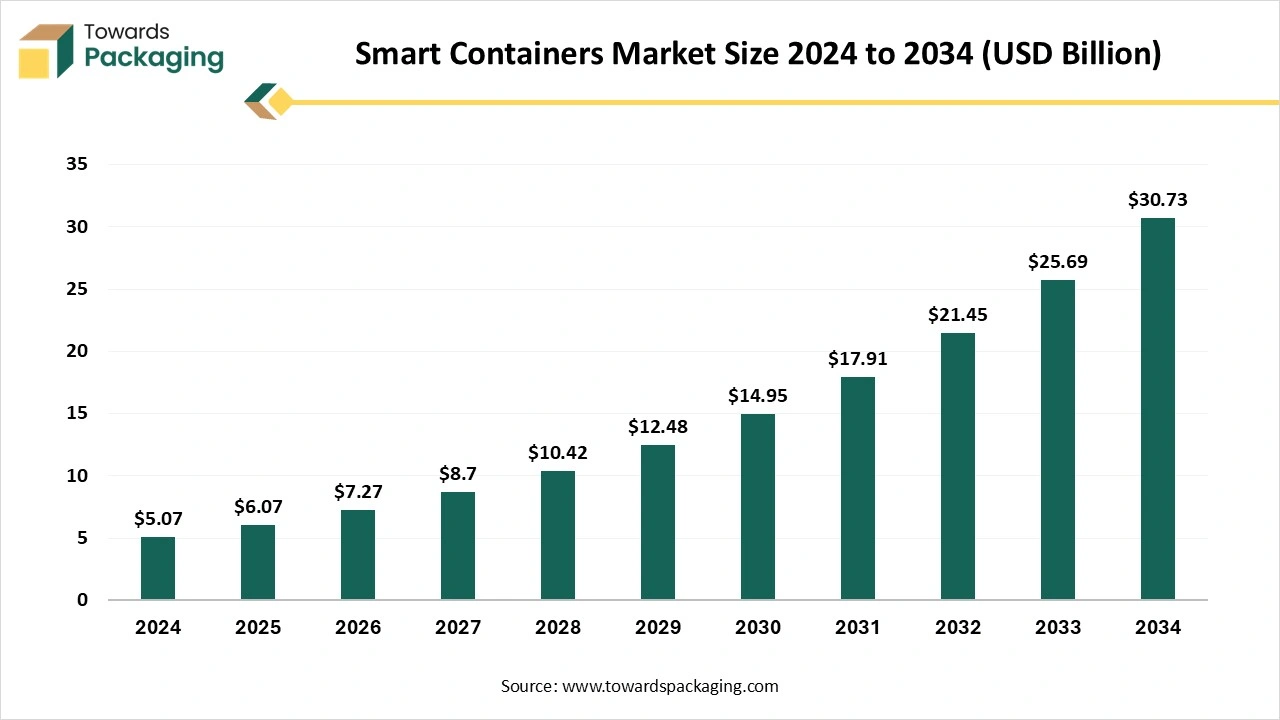
Smart containers are shipping containers with advanced technologies such as communication devices, sensors, and various other facilities. These are useful in providing real-time information such as temperature, location, humidity, condition of the cargos, and various other aspects. These containers data bring security and efficiency to intermodal transportation. These are of three types: dry storage containers, open side containers, and half-height containers. Growing awareness about cargo security and the necessity to comply with worldwide certification values are influencing the acceptance of progressive container technologies. Businesses are capitalizing on smart resolutions to safeguard their shipments and meet strict security guidelines and quality standards. The importance of supervisory obedience and improved safety events is enhancing the demand for cultured tracking and monitoring systems.
| Metric | Details |
| Market Size in 2024 | USD 5.07 Billion |
| Projected Market Size in 2034 | USD 30.73 Billion |
| CAGR (2025 - 2034) | 19.63% |
| Leading Region | North America |
| Market Segmentation | Offering Outlook, Technology Outlook, Application Outlook, End Use Outlook and By Region Covered |
| Top Key Players | MSC Group, Maersk, CMA CGM, COSCO Shipping Lines, Hapag-Lloyd, Ocean Network Express |
Growing Demand for Continuous Development
The growing demand for continuous technological development is influencing the growth of this sector, as with the advancement of technology, it becomes easier to get real-time updates of the products.
Growing Demand for Real-time Monitoring Facility
A growing concern for real-time monitoring facilities for enhanced security status, mainly in sectors such as food & beverages and pharmaceuticals. These sectors require extra safety measures due to the high perishable products.
Presence of Predictive Analytics and Artificial Intelligence
The ease due to the presence of predictive analytics to protect products from damaging and artificial intelligence that assures the quality maintenance during shipping has raised the demand for such advancement.
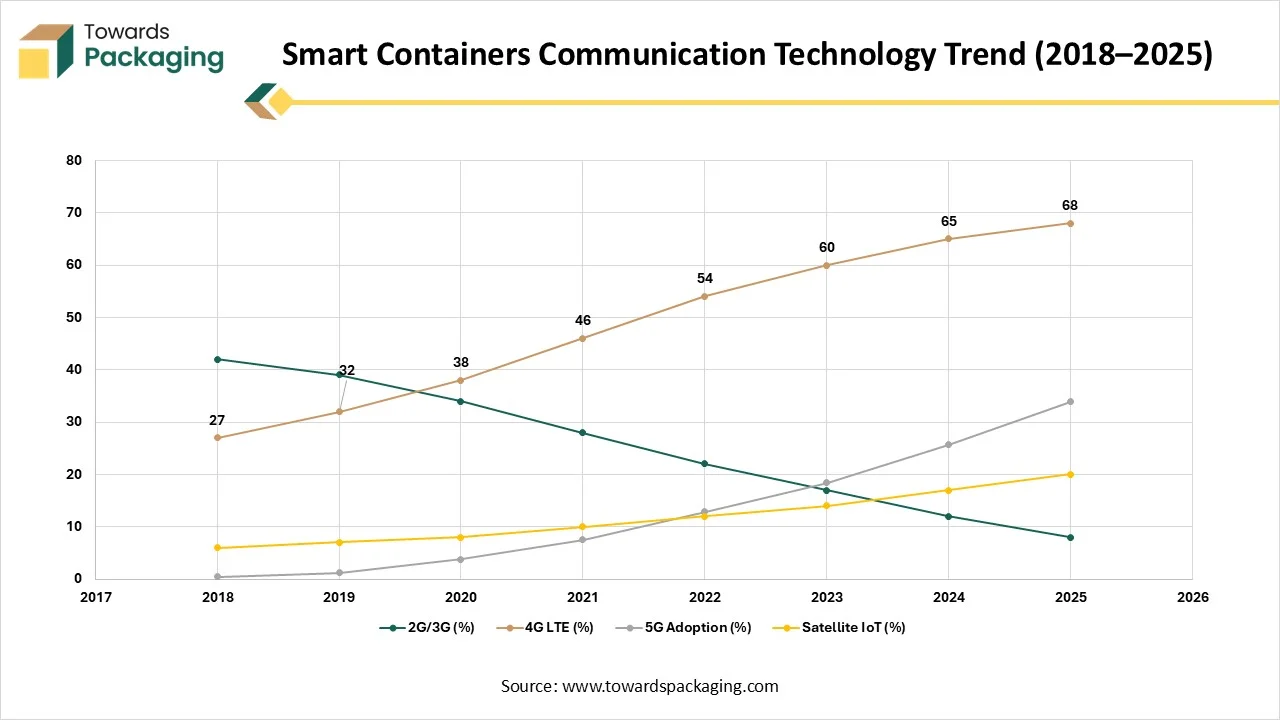
| Year | 2G/3G (%) | 4G LTE (%) | 5G Adoption (%) | Satellite IoT (%) |
| 2018 | 42 | 27 | 0.4 | 6 |
| 2019 | 39 | 32 | 1.2 | 7 |
| 2020 | 34 | 38 | 3.8 | 8 |
| 2021 | 28 | 46 | 7.5 | 10 |
| 2022 | 22 | 54 | 12.9 | 12 |
| 2023 | 17 | 60 | 18.4 | 14 |
| 2024 | 12 | 65 | 25.7 | 17 |
| 2025 | 8 | 68 | 33.9 | 20 |
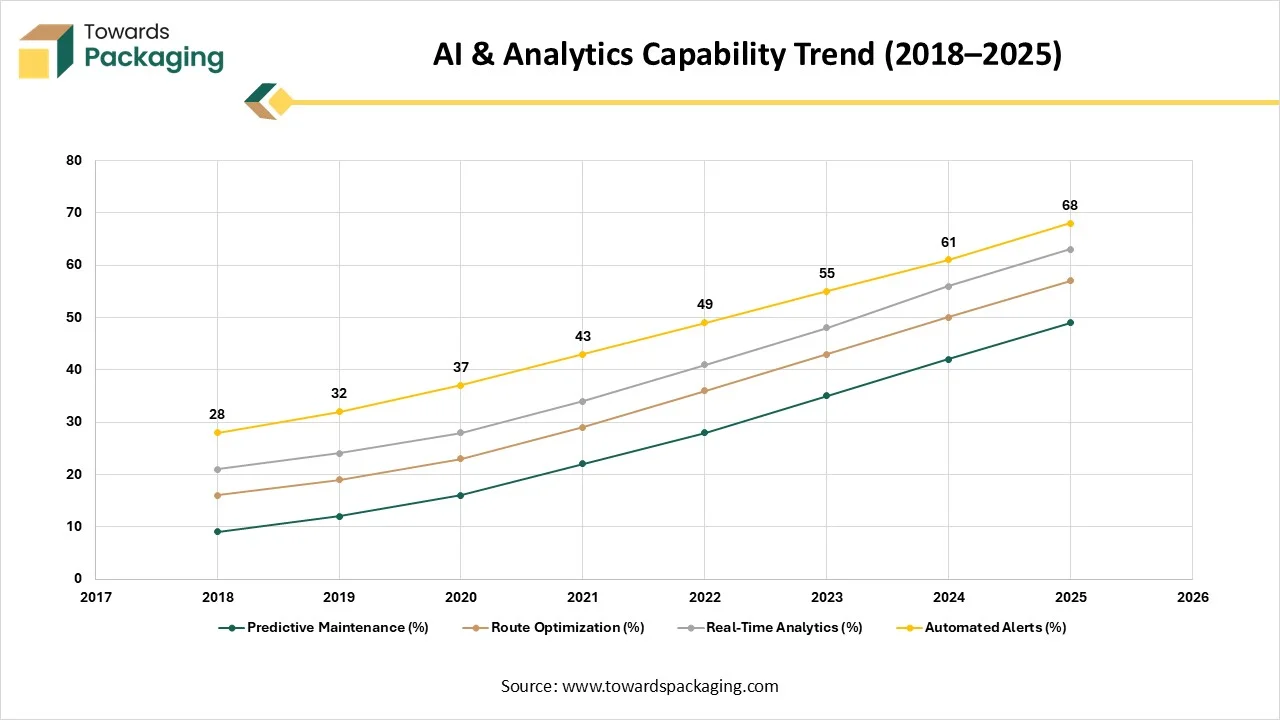
| Year | Predictive Maintenance (%) | Route Optimization (%) | Real-Time Analytics (%) | Automated Alerts (%) |
| 2018 | 9 | 16 | 21 | 28 |
| 2019 | 12 | 19 | 24 | 32 |
| 2020 | 16 | 23 | 28 | 37 |
| 2021 | 22 | 29 | 34 | 43 |
| 2022 | 28 | 36 | 41 | 49 |
| 2023 | 35 | 43 | 48 | 55 |
| 2024 | 42 | 50 | 56 | 61 |
| 2025 | 49 | 57 | 63 | 68 |
The role of AI in the smart containers market is significant, as it is important for the advancement of the containers. It helps in real-time monitoring of the products packed in the containers and estimates the time to deliver those products. These artificial intelligence tools can easily predict the delivery delays and recognize the inefficiencies present on the routes. It can detect the temperature, which helps to take preventive measures that help to maintain the integrity of the products. With the predictive analytics facility, it becomes easy for market players to analyse all the historical data and make changes according to the current trends. It helps to estimate the delivery of a suitable number of containers at different times. It is also useful in maintaining the equipment and containers to protect them from sudden and major breakdowns. The movement of the containers is easily visible with AI algorithms in the smart containers and also through smart cameras.
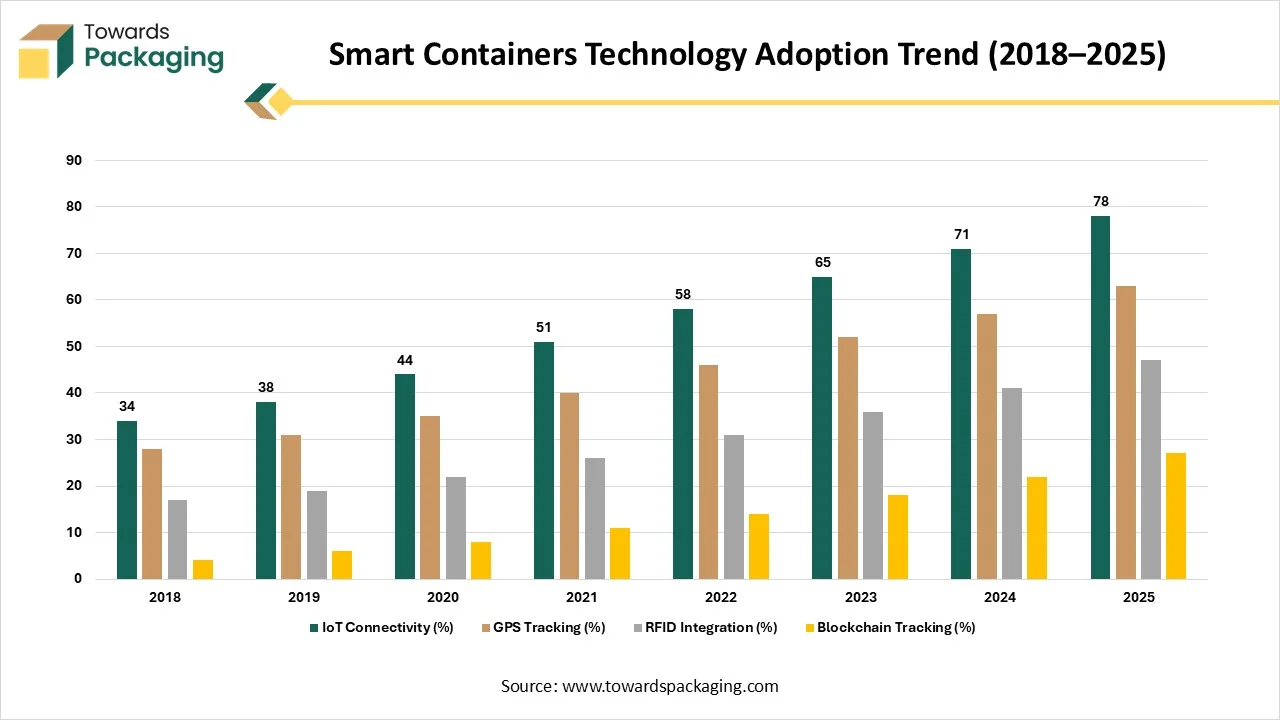
| Year | IoT Connectivity (%) | GPS Tracking (%) | RFID Integration (%) | Blockchain Tracking (%) |
| 2018 | 34 | 28 | 17 | 4 |
| 2019 | 38 | 31 | 19 | 6 |
| 2020 | 44 | 35 | 22 | 8 |
| 2021 | 51 | 40 | 26 | 11 |
| 2022 | 58 | 46 | 31 | 14 |
| 2023 | 65 | 52 | 36 | 18 |
| 2024 | 71 | 57 | 41 | 22 |
| 2025 | 78 | 63 | 47 | 27 |
Rising concern for real-time monitoring and visibility
The increasing demand for real-time monitoring of the containers to prevent any damage and monitoring the smart containers market efficiently are highly utilized. It helps to provide the appropriate information regarding humidity level, temperature conditions, and the condition of the goods. This makes it possible for companies to improve their supply chain management and the movement of goods in transit. The corporates can easily monitor the situation of perishable products and react actively on time to any matter to avoid loss. By utilizing the real-time data, the market players can enhance the safety of products in transportation, decrease the risk of spoilage and damage and improve inventory levels, and also expand the general functioning efficacy.
The growing acceptance of digitalization and IoT (Internet of Things) in the logistics sector is one of the major drivers of the market. Internet of things equipment and sensors rooted in smart containers allow the gathering and spread of real-time statistics, which can be used to get useful insights into the distribution supply chain. This information can be utilized to improve shipping methods, decrease transportation times, and expand the overall efficacy of logistics processes. Moreover, the incorporation of digital skills such as cloud computing and blockchain is further increasing the abilities and usage of smart containers.
The growing consciousness of ecological sustainability is influencing the demand for more eco-friendly and sustainable shipping choices. These smart containers play an important role in this by allowing the optimization of shipping methods and decreasing fuel consumption. The capacity of smart containers to observe fuel practices and releases allows industries to make informed choices to decrease their ecological impact.
Rising charges for the containers
With the advancement of these containers, there is a huge upsurge in the charges of the smart containers, which has become a major hinder in the growth of the market. The primary focus of the major market players is to make these containers available at an affordable price.
Eco-friendly and sustainable packaging options
Due to the growing demand for sustainable and eco-friendly packaging options, the global smart containers market is surging rapidly. The rising consciousness of ecological sustainability is influencing the demand for eco-friendly and more sustainable smart shipping containers. Advancement in the Internet of Things and connectivity show several opportunities for the manufacturer of these containers. Constant advancement in IoT technologies and network expansion are anticipated to meaningfully upsurge smart container abilities.
Advanced connectivity is predictable to allow unified and faster communication between centralized systems and smart containers, and it is expected to improve advanced real-time data and complete performance. These developments can result in smarter and more consistent resolutions, proficient in carrying enhanced-quality data and a quicker response period. The cooperation between progressive IoT abilities and connectivity enhancements is designed to improve the role of smart containers in logistics, introducing opportunities for distribution chain management to be smarter and faster in the future.
The necessity for physical elements such as RFID tags, sensors, and GPS devices for real-time information and observation of the containers. These are extremely useful in maintaining the integrity of the products by monitoring the humidity level, temperature, and location of the containers. The major components, like humidity and temperature monitors, GPS sensors, and RFID tags, are the most essential for the safe and good quality transit of the high-value and perishable products. On the other hand, the software segment is growing rapidly in the market due to the growing requirement for important data, predictive maintenance abilities, and real-time observation has raised the demand for such facilities through which all the required information can easily be gathered. The incorporation of cloud computing, IoT, and AI permits faster and smarter decision-making to reduce the risk of damage to the products being transported.
GPS plays an important role in getting the information about the exact locations and tracking the capabilities of the smart containers. Incorporation of such software has improved the level of security in the containers, and also, the process of optimizing the route becomes easy. It enhances the timely delivery and ensures the better condition of the products. LoRA WAN is growing rapidly because of its ability to provide low-power connectivity ideal for Internet of Things applications in logistics. It has high compatibility with varied sensors for monitoring humidity, temperature, and several other conditions that make it an adaptable option for improving efficiency and visibility.
The asset tracking and management segment is widely accepted, as there is an urgent requirement for supply chain logistics. It is widely used to understand the condition of the containers. It allows constant monitoring that helps market players to deliver products timely manner and reduce downtime. On the other hand, the supply chain optimization segment is anticipated to grow with the highest CAGR in the market during the studied years. This enhances the efficiency and decreases the charges across logistics operations. By leveraging advanced analytics and real-time data, businesses can reduce operational costs, enhance consumer satisfaction, and improve decision-making procedures.
The food and segment is dominating due to the necessary requirement of the containers to maintain the safety and freshness of the food products at the time of transportation. The high-quality protection of food products with advanced technology has raised the adoption of these containers in this sector. The pharmaceuticals segment is expected to grow at the fastest rate in the market during the forecast period of 2024 to 2034. This is due to the strict necessities for maintaining and monitoring the quality of the medical products at the time of transportation. It is easy to transport temperature-sensitive chemicals, and a monitoring system enhances the convenience of transporting other heavy diagnostic equipment.
North America held the largest share of the smart containers market in 2024, due to the presence of advanced logistics infrastructure and rapid acceptance of IoT technologies. Countries like North America and Canada are highly focused on increasing the transparency and efficiency of the supply chain. The strict rules of the supervisory body to develop eco-friendly packaging with advanced technology to reduce the risk of damage have influenced this market development.
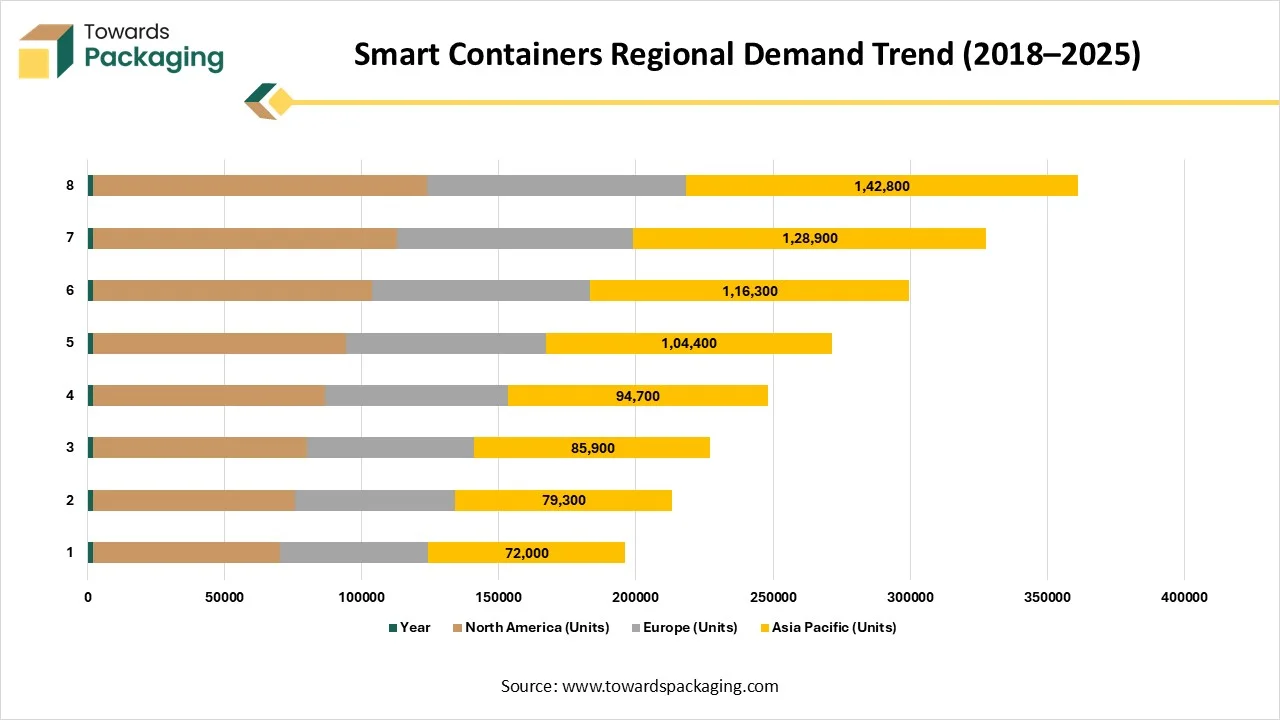
| Year | North America (Units) | Europe (Units) | Asia Pacific (Units) |
| 2018 | 68,000 | 54,000 | 72,000 |
| 2019 | 73,500 | 58,400 | 79,300 |
| 2020 | 77,900 | 61,200 | 85,900 |
| 2021 | 84,600 | 66,800 | 94,700 |
| 2022 | 92,300 | 72,900 | 1,04,400 |
| 2023 | 1,01,800 | 79,600 | 1,16,300 |
| 2024 | 1,10,700 | 86,200 | 1,28,900 |
| 2025 | 1,21,900 | 94,500 | 1,42,800 |
Asia Pacific is anticipated to grow at the fastest rate in the smart containers market during the forecast period. In countries such as India, China, Japan, South Korea, Thailand, and several others, there is a huge upsurge in the development of industries that influence the transporting business significantly, resulting in huge demand for containers with advanced technology. The rapid industrialization and government initiatives have raised the market to develop exponentially.
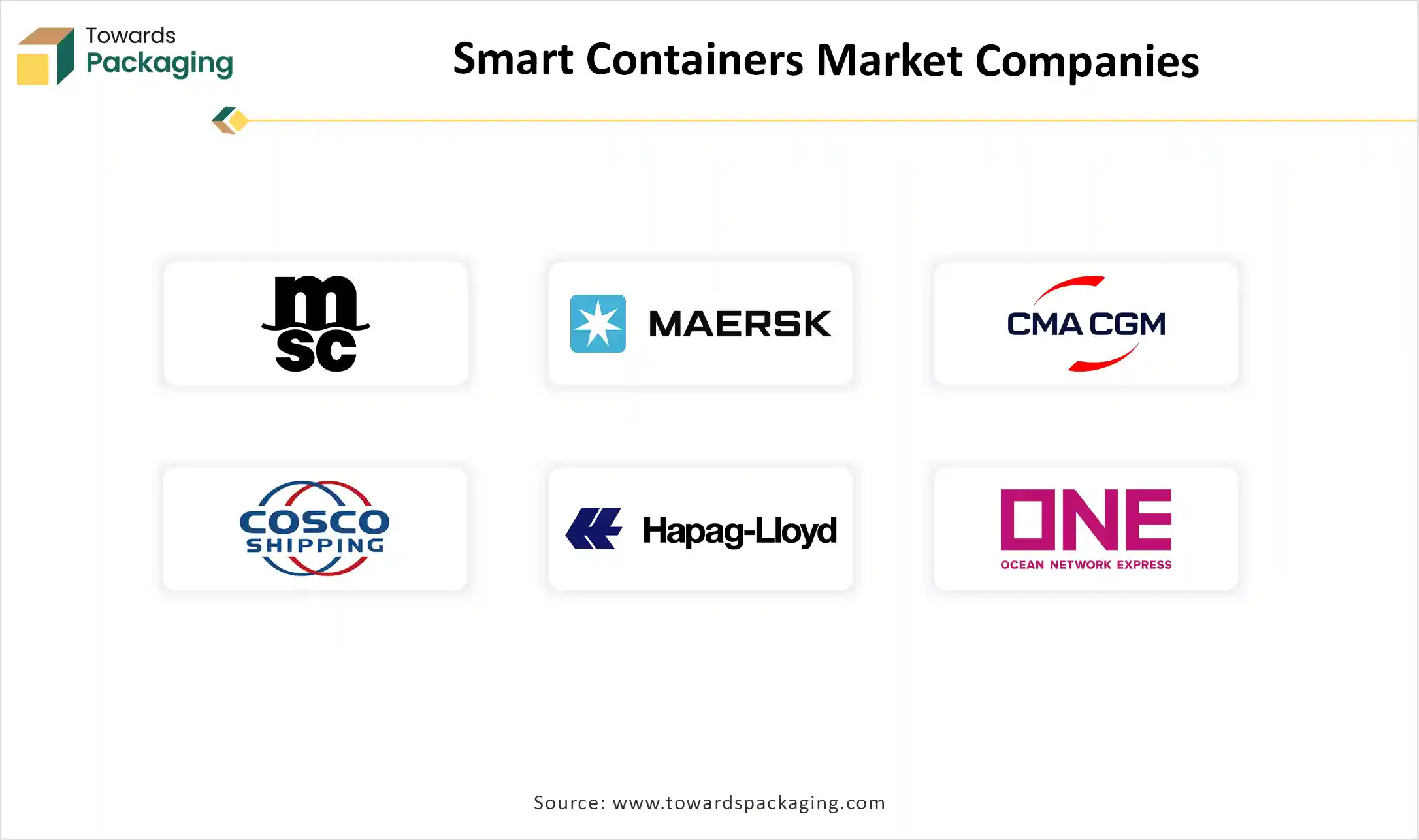
Offering Outlook
Technology Outlook
Application Outlook
End Use Outlook
By Region Covered
November 2025
November 2025
November 2025
November 2025